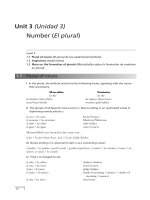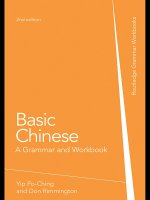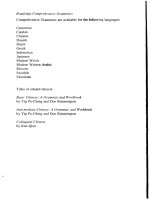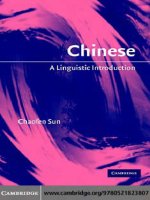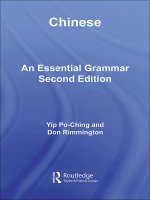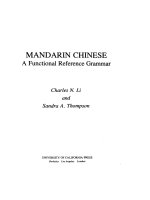chinese a comprehensive grammar
Bạn đang xem bản rút gọn của tài liệu. Xem và tải ngay bản đầy đủ của tài liệu tại đây (15.56 MB, 436 trang )
Routledge Comprehensive Grammars
Comprehensive Grammars are available for the following languages:
Cantonese
Catalan
Chinese
Danish
Dutch
Greek
Indonesian
Japanese
Modern Welsh
Modern Written Arabic
Slovene
Swedish
Ukrainian
Titles of related interest
Basic Chinese: A Grammar and Workbook
by Yip Po-Ching and Don Rimmington
Intermediate Chinese: A Grammar and Workbook
by Yip Po-Ching and Don Rimmington
Colloquial Chinese
by Kan Qian
CHINESE:
A COMPREHENSIVE
GRAMMAR
Yip Po-Ching and
Don Rimmington
Routledge
Taylor &. Francis Group
LONDON AND NEW YORK
First published 2004
by Routledge
11 New Fetter Lane, London EC4P 4EE
Simultaneously published in the USA and Canada
by Routledge
29 West 35th Street, New York, NY 10001
Routledge is an imprint of the Taylor & Francis Group
© 2004 Yip Po-Ching and Don Rimmington
Typeset in Times by Graphicraft Limited, Hong Kong
Printed and bound in Great Britain by TJ International Ltd, Padstow, Cornwall
All rights reserved. No part of this book may be reprinted or reproduced or
utilised in any form or by any electronic, mechanical, or other means, now
known or hereafter invented, including photocopying and recording, or in
any information storage or retrieval system, without permission in writing
from the publishers.
British Library Cataloguing in Publication Data
A catalogue record for this book is available from the British Library
Library of Congress Cataloging in Publication Data
Yip,
Po-Ching, 1935-
Chinese : a comprehensive grammar / Yip Po-Ching and Don Rimmington.
p.
cm. - (Routledge comprehensive grammars)
1.
Chinese language-Grammar. I. Title. II. Series.
PL1107.Y56 2003
495.1'82421-dc21 2003010198
ISBN 0-415-15031-0 (hbk)
ISBN 0-415-15032-9 (pbk)
CONTENTS
Acknowledgements xiv
List of Abbreviations xv
Introduction xvi
1 Nouns and Nominalisations 1
1.1 Nouns and categorisation 1
1.1.1 Common nouns 1
1.1.2 Material nouns 3
1.1.3 Collective nouns 4
1.1.4 Abstract nouns 5
1.1.5 Proper nouns 5
1.1.6 Temporal and spatial nouns 6
1.2 Nouns and reference 7
1.2.1 Definite or indefinite/generic reference 7
1.2.2 Exclusive reference 9
1.3 Nouns and plurality 9
1.4 Nouns and syntactic functions 11
1.5 Nouns and semantic fields 13
1.6 Nominalisations 16
2 Numerals and Measures 17
2.1 Digits, units and cardinal numbers 17
2.2 Ordinals 19
2.3 Enumeration 20
2.4 Fractions, percentages and decimals 20
2.4.1 Fractions 20
2.4.2 Percentages 21
2.4.3 Decimals 21
2.5 Imprecise numbers, halves and multiples 22
2.5.1 Imprecise numbers (^1)iic yueshu) 22
2.5.2 Halves 25
2.5.3 Multiples 25
2.6 Mathematical symbols and simple arithmetic equations 26
2.7 The multiplication table 26
2.8 Measure words 27
2.8.1 Standard measures 27
2.8.2 Classifying measures 32
vi Contents
2.9 Measure words and other attributives 41
2.10 Reduplication of measure words 43
2.11 Missing measure words 44
2.12 Disyllabic measure words 46
2.13 Compound measure words 46
2.14 Duration and frequency measures 46
Pronouns, Pronominals and Pro-words 47
3.1 Personal pronouns 47
3.2 Demonstrative pronouns 48
3.3 Interrogative pronouns 50
3.4 Indefinite pronouns 52
3.5 Enumerative pronouns 54
3.6 Pronominals 54
3.7 Pro-words 56
Adjectives as Attributives and Predicatives 58
4.1 Adjectives in Chinese 58
4.2 Qualifiers or quantifiers 59
4.3 Degree adverbs and complements 60
4.4 The descriptive indicator #J de 62
4.5 Attributives and predicatives 65
4.5.1 Adjectives and their functional capacity 65
4.5.2 Attributive-only adjectives 67
4.5.3 Predicative-only adjectives 68
4.6 Various inherent features of adjectives 69
4.6.1 Gradable vs non-gradable 69
4.6.2 Conditional vs unconditional 70
4.6.3 Derivable vs non-derivable 70
4.6.4 Reduplicable vs non-reduplicable 71
4.6.5 Derogatory vs commendatory 72
4.7 Adjectives and valency 73
4.8 Adjectives and collocation 73
4.9 Adjectives and comparison 74
Attributives other than Adjectives 76
5.1 The different forms of attributive 77
5.1.1 Nouns 77
5.1.2 Verbs 78
5.1.3 Clauses 78
5.1.4 Prepositional or postpositional phrases with &5 de 78
5.1.5 Numerals or demonstratives and measure words 79
5.1.6 Pronouns 80
5.1.7 Idioms 80
5.2 The sequencing of attributives 81
Contents vii
5.3 Combination, embedding and delaying 85
5.3.1 Commas or conjunctions 85
5.3.2 Longer attributives 86
Action Verbs 88
6.1 Transitive and intransitive 89
6.2 Dynamic and static differences 91
6.3 Dative verbs 91
6.4 Causative verbs 95
6.5 Coverbs 98
6.6 Agreement between the subject and its action verb predicate 99
6.7 Agreement between an action verb and its object 101
6.8 Action verbs: completion and continuation 102
6.8.1 The completion aspect 102
6.8.2 The continuation aspect 105
6.9 Action verbs: manner described and experience explained 107
6.9.1 Manner of existence with J| zhe 107
6.9.2 Persistent posture or continuous movement with ^f zhe 108
6.9.3 Accompanying manner with JJ zhe 108
6.9.4 Experience and M guo 109
Action Verbs and Time 112
7.1 Point of time 112
7.2 Duration 113
7.3 Brief duration 116
7.4 Frequency 118
7.5 ft mei 'every' 120
7.6 Other time expressions 120
7.7 Negation and time reference 121
7.7.1 Negative expository sentences 121
7.7.2 Negative narrative sentences 122
7.7.3 Negative descriptive sentences 123
Action Verbs and Locations 124
8.1 Location expressions and position indicators 124
8.2 4 zai with location expressions 126
8.3 Location expressions as sentence terminators 127
8.4 Location expressions as sentence beginners 129
8.5 Direction indicators 131
8.5.1 Simple direction indicators 3lt lai 'to come' and
i: qu 'to go' 131
8.5.2 Disyllabic direction indicators 132
8.5.3 Direction indicators indicating meaning other than
direction 134
8.6 The destination indicator 3\ dao 'to arrive' 136
viii Contents
9 Adverbials 138
9.1 Restrictive adverbials 138
9.1.1 Time expressions 138
9.1.2 Monosyllabic referential adverbs 141
9.2 Descriptive adverbials 143
9.3 Initiator-orientated or action-oriented descriptive adverbials 145
9.4 Omission of the descriptive marker ife de 147
9.5 Relative position of adverbials 148
10 Complements 150
10.1 Resultative complements 150
10.1.1 Adjectival resultative complements 150
10.1.2 Verbal resultative complements 151
10.1.3 Resultative complements in ffi ba, tt bei and
notional passive constructions 152
10.1.4 Resultative complements and intended/expected
11
12
10.2
10.3
outcomes in imperative sentences
Potential complements
10.2.1 Adjectival potential complements
10.2.2 Verbal potential complements
10.2.3 Potential directional complements
10.2.4 Figurative uses and other features of resultative
complements
Complements of manner and consequential state
Coverbs
11.1
11.2
11.3
ffiba
12.1
Peer characteristics
11.1.1 Registral
11.1.2 Collocational
11.1.3 Governmental
11.1.4 Prosodic
11.1.5 Sequential
11.1.6 Usage
Semantic categories
11.2.1 Direction and position
11.2.2 Time
11.2.3 With, for or by someone or something
11.2.4 Instrument and vehicle
11.2.5 By means of, in accordance with, etc.
11.2.6 Grammatical operators
Coverbal positions
Constructions
The structural features of fE ba construction
153
153
153
154
154
155
155
159
160
160
160
161
162
162
163
163
164
174
180
183
185
193
196
200
200
Contents ix
The
13
13
13
.1
.2
.3
Passive
Three
Voice and W bei Constructions
forms of passive
The notional passive
The formal passive
13.3.1
13.3.2
13.3.3
13.3.4
13.3.5
Salient features
Basic characteristics
Imperatives
Whole-part relationships
A classical variant
12.1.1 Definite-referenced object 201
12.1.2 The elements after the main verb 201
12.1.3 The main verb in a ffi ba construction 204
12.2 Intentionality in a ffi ba construction 205
12.3 ffi ba construction and imperatives 206
12.4 A particular feature of ffi ba construction in evaluative
sentences 207
12.5 IE ba versus # jiang 208
13 The Passive Voice and ft bei Constructions 209
209
210
217
217
218
220
220
221
13.4 The lexical passive 221
14 Chain Constructions 226
14.1 The first verb introducing a coverbal phrase that indicates
location, etc. 226
14.2 The second verb indicating purpose 227
14.3 The first verb indicating reason or cause 232
14.4 The first verb expressing accompanying manner or
circumstances 234
14.5 Consecutive actions 236
14.6 Simultaneous actions 240
14.7 An emphatic chain construction 240
14.8 An articulated chain construction 241
15 The Verb Ji shi 243
15.1 Jl shi introducing a predicative 243
15.2 Predicatives with an optional Jk shi 247
15.3 ft shi indicating existence 248
15.4 JE shi expressing emphasis 250
15.5 Jl: shi assessing an overall situation 255
15.6 & shi forming part of a connector 256
15.7 JH shi as a pivot 257
16 The Verb M you 258
16.1 ^ you indicating possession 258
16.2 W you indicating existence 259
x Contents
16.3 W you introducing subjects and time or location expressions
of indefinite reference 261
16.4 W you specifying degree or extent 263
16.5 M you introducing comparison 264
16.6 -fi" you as an adjectival formative 264
16.7 M you expressing ideas of development and change 265
16.8 ^ you introducing a conditional clause 265
16.9 $t(W) mei(you) as negator of action verbs 266
16.9.1 Negator of past action/experience 266
16.9.2 Affirmative-negative questions and past action/
experience 266
16.9.3 Another form of the question 267
267
268
17 Verbs that Take Verbal or Clausal Objects 269
270
270
271
272
272
272
273
273
273
274
275
276
18 Modal Verbs 278
278
278
279
280
281
282
283
285
285
286
286
287
288
16.10
16.11
Verbs
17.1
17.2
17.3
17.4
17.5
Modal
18.1
18.2
18.3
18.4
-n you
* you
to indicate 'part of
as the first verb in a sequence
that Take Verbal or Clausal Objects
Intentior
17.1.1
17.1.2
17.1.3
17.1.4
17.1.5
17.1.6
17.1.7
l and aspiration
Positive intentions and aspirations
Negative intentions
Uncertain aspirations
Group intentions
Voiced intentions
Intentions put into practice
Frustration and compulsion
Attitudes
Knowing and thinking
Appearance and value
Dummy
Verbs
verbs
Semantic categories of modal verbs
18.1.1
18.1.2
18.1.3
18.1.4
18.1.5
18.1.6
18.1.7
18.1.8
18.1.9
Speaker
Permission
Possibility
Probability
Ability or skill
Obligation
Wishing
Willingness
Necessity
Boldness
perspective of modal verbs
Negation of modal verbs
Grammatical orientation of modal verbs
Contents xi
19 Telescopic Constructions 290
19.1 Topic and sub-topic 290
19.2 Topic and subject 292
19.3 'Subject + predicate' as topic 294
19.4 '(Subject) + predicate' inserted between 'topic' and
'comment' 294
20 Narration, Description, Exposition and Evaluation 296
20.1 Narrative sentences 297
20.2 Descriptive sentences 303
20.3 Expository sentences 306
20.3.1 Topic-comment expository sentences 306
20.3.2 Subject-predicate expository sentences 308
20.3.3 Negation of expository sentences 309
20.4 Evaluative sentences 310
20.4.1 The modal verb evaluative 310
20.4.2 The modified adjective/complement evaluative 311
20.5 Comparisons between sentence types 311
20.6 Concluding remarks 314
21 7 fe-Expository Sentences 315
21.1 Change or reversal of a previous situation 316
21.2 Subjective endorsement behind the objective explanation 319
21.3 Summing up after a series of actions 320
21.4 A rhythmic necessity for monosyllabic verbs or verbalised
adjectives 321
21.5 Two or three functions in one 323
21.6 /^-expository sentences and the four basic sentence types 323
21.6.1 Expository sentences 324
21.6.2 Narrative sentences 324
21.6.3 Descriptive sentences 325
21.6.4 Evaluative sentences 326
22 Conjunctions and Conjunctives 328
22.1 Conjunctions that link words or phrases 328
22.1.1 The four conjunctions 328
22.1.2 W er 'also' 329
22.1.3 # bing 'also' 330
22.2 Clausal conjunctions and conjunctives 330
22.3 Clausal conjunctions and conjunctives in semantic categories 331
22.3.1 Giving reasons: because, because of, therefore 331
22.3.2 Making inferences: since 333
22.3.3 Expressing supposition: if 334
xii Contents
22.3.4 Stating conditions: only if, only when 336
22.3.5 Offering concessions: though, although, yet 337
22.3.6 Defying setbacks: no matter 339
22.3.7 Clarifying time: when, as soon as, after, before, etc. 340
22.3.8 Indicating preference: would rather 342
22.3.9 Elucidating one's purpose: in order to, so as to,
so as not to 343
22.3.10 Encoding miscellaneous relational concepts:
apart from, let alone, otherwise 344
22.4 Correlations and parallels 344
22.5 Zero connectives 345
23 Interrogative Sentences 347
23.1 Yes-no questions 347
23.2 Surmise questions 349
23.3 Suggestions in the form of questions 350
23.4 Alternative questions 350
23.5 Affirmative-negative questions 351
23.6 Question-word questions 352
23.7 Follow-up queries with % ne 356
23.8 Rhetorical questions 356
23.9 Exclamatory questions 357
24 Imperatives and Exclamations 359
24.1 Verbs in imperatives restricted to voluntary actions 360
24.2 Imperatives: beginners and end-particles 360
24.3 Spoken and written requests 364
24.4 Interjections and exclamatory expressions 365
24.5 Exclamations: particles and degree adverbials or
complements 371
25 Abbreviations and Omissions 373
25.1 Abbreviations in answers to questions 373
25.2 Abbreviations in face-to-face exchanges 374
25.3 Abbreviations in comparisons 374
25.4 The hidden presence of the narrator in a narrative 375
25.5 Omissions in a discourse 375
26 Prosodic Features 379
26.1
The overall rhythm of Chinese speech 379
26.2 Syntactic sequences and their underlying rhythm 385
26.2.1 'Verb + object'patterns 385
26.2.2 The 'attributive + headword' pattern 387
26.3 Echoing patterns of rhythm 389
Contents xiii
26.4 Expanding, condensing and padding to get into the
appropriate rhythm 390
27 Stylistic Considerations in Syntactic Constructions
27.1 The presentational factor
27.1.1 Layered or sequential images
27.1.2 Reiteration for cumulative effect
27.1.3 Factorisation
27.1.4 Parallel matching
27.1.5 Inversion: attributives or adverbials after their
headwords
27.2 The rhetorical factor
27.2.1 Coupling: XY, XY
27.2.2 Progression: XY, XY, XY
27.2.3 Echoing
27.2.4 Alternation: long and short sentences
27.3 Concluding remarks
Bibliography
Index
392
392
393
394
396
397
399
399
399
401
402
403
404
405
408
ACKNOWLEDGEMENTS
The authors wish to thank Ms Li Quzhen for all her help with the pinyin anno-
tations of the illustrative examples. Without her assistance and support the project
would never have been completed.
The authors also wish to thank members of the British Chinese Language
Teaching Seminar (an affiliated body of the British Association of Chinese
Studies, under the Oxford China Centre) for valuable suggestions on grammat-
ical problems.
Any errors are, of course, entirely the responsibility of the authors.
Yip Po-Ching and Don Rimmington
May 2003
ABBREVIATIONS
adj.
cl.
class.
colloq.
cv
dial.
dv
fml.
infml.
lit.
mv
mw
n.
neut.
num.
obs.
P-
pron.
s.
svo
vb.
vs.
adjective
clause
classical
colloquial
coverb
dialect
dummy verb
formal
informal
literally
modal verb
measure word
noun
neutral
numeral
obsolete
predicate
pronoun
subject
subject-verb-object
verb
versus
INTRODUCTION
This book aims to provide a comprehensive grammar of Chinese. It is intended
for readers who have some knowledge of the language and are at ease with
its written form, whether in traditional characters or romanisation. We have
endeavoured to minimise the use of technical expressions, but, where linguistic
terms are introduced, we have provided explanations.
We believe that a comprehensive grammar has to be comprehensive in two
senses. First, it must highlight the specific characteristics of the language being
described and, where appropriate, indicate how they differ from those of other
languages. In the case of Chinese, for example, syntactic rules are often seen to
be operational in conjunction with semantic, prosodic and discoursal principles.
Second, the grammar must be able to cover (and therefore generate) all possible
(and acceptable) constructions in the language. We have consequently adopted
an eclectic approach and have made reference to a range of grammatical theories
in order to achieve what we hope is a multi-perspective approach: semantic,
pragmatic, stylistic, prosodic, structural, functional, discoursal, transformational
and generative. In our view syntactic generalisations become comprehensive
only when they are underpinned by judgements on particular language charac-
teristics that draw on theoretical approaches relevant to those characteristics.
THE LAYOUT OF THE GRAMMAR
For ease of reference, each chapter provides an independent exposition of a
particular grammatical feature and can be consulted by readers wishing to inves-
tigate that feature. Footnotes offer cross-references to related issues in other
chapters. Lists of language examples are given throughout to illustrate points
under discussion, and each example is in Chinese script and romanisation, with
an English translation and, where needed, a literal translation.
The book lays particular stress on functional types of sentence in Chinese,
and this has influenced the sequencing of chapters. The non-morphological
nature of the language with the resultant absence of noun and verb inflection, and
of general markers for definite and indefinite reference, means that most gram-
matical features have to be seen in the context of the sentence, or more usefully
the sentence type, as a whole. We have identified four basic sentence types and
a fifth overriding type, and these are discussed in detail in Chapters 20 and 21.
The four basic types are: narrative (action-verb based and associated with the
completed action marker); descriptive (again generally featuring action verbs,
but with continuous action markers); expository (covering a range of explanatory
Introduction xvii
statements, relating to existence, possession, cognition, experience, etc., with
no verbal markers apart from one indicating experience); and evaluative (also
explanatory statements, but with a more judgemental tone, featuring modal verbs,
etc.,
but with no verbal markers). Narrative and descriptive sentences have a
subject-predicate structure, while expository and evaluative sentences are more
likely to follow a topic-comment pattern. The endless variability and invention
of language means that this typology will inevitably have loose ends and over-
lapping dimensions, and the presence or function of sentence elements will
sometimes blur the boundaries between types, but nonetheless we hope that the
structure we propose will offer some clarification of the complexities of Chinese
grammar.
The fifth overriding type we have called fe-expository, because the particle le
T is present at the end of the sentence, and its presence introduces a notion of
change or reversal which the speaker expresses with varying degrees of personal
involvement. Le can in fact be added to any of the four sentence types identified
above, and, as we shall see, it has a significant impact on the meaning of the
sentence. Le-expository sentences are a highly distinctive feature of the Chinese
language, and, because they express some degree of endorsement by a speaker,
they are a particular feature of the spoken language.
The layout of the book reflects this typology. The first five chapters deal with
noun-related issues; Chapters 6 to 14 discuss elements in narrative and de-
scriptive sentences; Chapters 15 to 19 are more concerned with expository and
evaluative sentences; Chapters 20 and 21, as we have said, analyse sentence
functional types; the final six chapters cover conjunctions, non-declarative sen-
tences (interrogative and imperative) and other elements at work in sentences
(omissions, and prosodic and stylistic features).
THE CHINESE LANGUAGE
The Chinese language, or group of related languages, is spoken by the Hans,
who constitute 94 per cent of China's population. One word for the language in
Chinese is Hanyu
?Xi§,
the Han language. Different, non-Han languages are
spoken by the other 6 per cent of the population, the so-called minority peoples,
such as the Mongols and the Tibetans.
The Chinese language is divided into a number of major dialects (with their
many sub-dialects). Speakers of different dialects in some cases find each other
unintelligible, but dialects are brought together by the fact that they share a
common script. This book describes the main and official dialect, which is
known by a number of names: Mandarin, modern standard Chinese, or putonghua
('common speech'). It is spoken in its various sub-dialect forms by almost three-
quarters of the Hans across the northern, central and western regions of the
country, but its standard pronunciation and grammar are associated with the
Beijing area of north China, though not with Beijing city
itself.
The other dia-
lects are Wu (spoken in Jiangsu and Zhejiang, including Shanghai), Xiang (in
xviii Introduction
Hunan), Cantonese (in Guangdong), Min (in Fujian), Hakka (in northeast
Guangdong and other southern provinces) and Gan (in Jiangxi).
Cantonese, Min and Hakka are widely spoken among overseas Chinese com-
munities. In Taiwan a form of Min dialect is used, though the official language
is Mandarin, brought over by the Nationalists in 1949, and called there guoyu
('national language'). Mandarin in also widely used in Singapore, where it is
known as huayu ('Chinese language'). Elsewhere, Chinese emigrants took their
particular dialects with them, and in Britain, for instance, the Chinese people,
who are largely from Hong Kong, almost all speak Cantonese.
The Chinese character script existed virtually unchanged for two thousand
years until a range of simplified forms began to be introduced by the main-
land Chinese government in the 1950s. These simplified characters, which we
employ in this book, are used throughout China and increasingly in Chinese
communities outside China, though not Taiwan. Chinese has been transcribed
into Western alphabetic script through various systems for over one hundred
years and this book makes use of the standard romanisation pinyin.
The formal written language of China until the early decades of the twentieth
century was Classical Chinese, which, as the vehicle for all publicly acknow-
ledged literature and for official documentation, was at the heart of the Chinese
cultural tradition. However, it had grown remote from spoken Chinese in syntax
and lexis, and had a position somewhat akin to medieval Latin in relation to the
Romance languages it had spawned. It was left behind by modern written styles,
based on spoken Chinese, which evolved over the last hundred years, but echoes
of Classical Chinese remain in contemporary speech and writing, especially in
literary and aphoristic registers. This continuing presence of the Classical today
will be mentioned at various points in our analysis.
1 NOUNS AND
NOMINALISATIONS
Nouns in Chinese are not specifically identified as being nouns except in the
case of those with suffixes like -f zi, JL er,
1
ik tou, etc. They are mainly
disyllabic, but there are also quite a number of monosyllabic nouns in every-
day vocabulary. Trisyllabic nouns are rare and polysyllabic nouns are even rarer,
the latter being often regarded as nominal phrases. Chinese nouns do not under
any circumstances inflect for case, gender or number,
2
though an unmarked
common noun is normally assumed as being plural, e.g. 4"> shu 'books' rather
than 'book'.
1.1 NOUNS AND CATEGORISATION
Nouns can be assigned to different categories with reference to their gram-
matical properties. Such categorisation, as we shall see, helps to highlight their
usages, and identifies distinctive features relating to the use of measure words,
definite and indefinite reference, plurality, etc.
1.1.1 COMMON NOUNS
Certain nouns are referrable to classes of tangible (and sometimes discrete)
entities, categories, events and phenomena in the natural or human world. They
are generally known as common nouns, and are linguistic labels we attach to
ourselves and our surroundings. For example:
ifA
ULl
ttfl-
m.
shlren
shan
shangdian
gou
rniidan
xie
van
poet
hill; mountain
shop
dog
peony
shoe(s)
salt
JL er is essentially a nominal suffix, but occasionally is found with other word classes, e.g. the
verb ScJL wanr 'to play, enjoy
oneself,
and with some reduplicated adjectives, e.g. iff if
JL
haohaor
'well, good'.
An unmarked common noun is normally assumed as being plural. Also see §1.3 for the specific
use of the plural suffix
i\
1
men.
2 Chinese: A Comprehensive Grammar
m
yuyan
yinyue
guanggao
dianying
bisai
zhanzheng
dizhen
language
music
advertisement
film; movie
contest
war
earthquake
Tangibility is not to be understood only in a macroscopic sense. Some entities
may not be visibly observable, but their existence can be verified by means of
instruments or by accompanying phenomena.
fe dian electricity
xibao [biology] cell
fenzi molecule
yuanzi atom
The so-called discreteness, on the other hand, does not necessarily imply separ-
ateness. Sometimes such discreteness may be more pragmatic than real. For
instance, Wft shuzhl 'branch, twig' is discrete but not separated from W^P
shugan 'tree trunk', and there is a similar pragmatic distinction between II tui
'leg'
and P jiao 'foot'.
However, a most distinctive feature of a Chinese common noun is that some kind
of measure word is normally used in conjunction with a number or demonstrat-
ive.
In some cases the measure is a classifier (a) and in others it is a universal or
standard measure (b),
3
which is generally associated with material nouns:
4
(a) — ffitij yi zuo shan a hill; a mountain
Hang duo huar two flowers; two blossoms
si jia shangdian four shops
wu dong fangzi five houses
nei ge ren that person
zhei ben shu this book
(b) ^$?7}c yi di shui a drop of water
san pian mianbao three slices of bread
yi bei cha a cup of tea
shi du dian ten units of electricity (for
billing a consumer)
wii gongjin mi five kilos of rice
ershi gongsheng qiyou twenty litres of petrol
3
See Chapter 2 for a full discussion of measure words in all their forms.
4
See §1.1.2 below.
Nouns and Nominalisations 3
1.1.2 MATERIAL NOUNS
There are a number of common nouns that may be regarded as material nouns.
One important feature of these nouns is that, unlike other common nouns, which
have their own specific measure words, material nouns must first be grouped,
packaged, partitioned or measured in terms of national or international standards
before they can be counted. For example:
boli glass
tie iron
shui water
kongqi air
They may only be used in connection with grouping, packaging, partitioning or
standard measures:
7JC
mmm
yi kuai boli
vl pian tie
san ping niunai
si duT ni
Hang dun tie
a (thick) piece of glass
a (thin) piece of iron
three bottles of milk
four heaps of earth
two tons of iron
(partitioning)
(partitioning)
(packaging)
(grouping)
(standard measure)
Material nouns can also be distinguished from other common nouns in two
further ways:
(a) While, as indicators of small or imprecise number or amount, —* ylxie
'some' and /I ji (plus measure) 'several; a few' can be used with any
common nouns, —J^(JL) yldian(r) 'a little' occurs only with material
nouns:
ZlffibJc
ylxie shu
ji ben shu
*yldian(r) shu
ylxie shui
ji tong shui
yldian(r) shui
some books
a few books
*a little books
some water
a few buckets/pails of water
a little water
(b) When suffixed by the particle fr5 de, a material noun more often indicates
composition rather than possession:
tong de
suliao de
boli de
(made of) brass
(made of) plastic
(made of) glass
4 Chinese: A Comprehensive Grammar
Compare the following sentences:
zhei ge hezi shi suliao de
(lit. this mw box is plastic de)
This is a plastic box. (material composition)
zhei ge hezi shi baba de
(lit. this mw box is father de)
This box belongs to father, (possession)
1.1.3 COLLECTIVE NOUNS
Another group of Chinese common nouns has an inbuilt notion of plurality.
They are known as collective nouns, and are usually formed by juxtaposing two
hyponyms (a) or by tagging a measure to a noun (b). For example:
(a)
Q-Bk
fumu parents (father and mother)
fufu a married couple (husband and wife)
zinii children (sons and daughters)
(Others include: ffli£ shisheng 'teachers and students', ifcM qfnyou 'friends and relatives', SSic
nannii 'men and women; boys and girls', AK renmin 'people (as opposed to government)', $t#
chengxiang 'cities and villages', KR yuanxiao 'academic institutions', 45t6 shubao 'publications
(books and newspapers)',
~XM:
wenjii 'stationery', W?K shiiniii 'trees', tfs; fancai 'food (cooked
rice and dishes for a meal)', Hi* caichan 'possessions', etc.)
(b) ^=fti cheliang vehicles (—ffi^ yl Hang che a/one car)
huaduo flowers (—^felfc yl duo hua a/one flower/blossom)
mapi horses (—E-Sj yi pi ma a/one horse)
(Others include: An renkou 'population', ftj£ qiangzhl 'rifles', I&K chuanzhi 'shipping', ^+
shuben 'books', *S5K zhizhang 'paper', ftft zhuankuai 'bricks', #31 shixiang 'matters', ^E
bupi '(bolts of) cloth', EBH tianmu 'cultivated land', etc.)
A common feature of these collective nouns is that they are not differentiable
into individual items by means of numerals and measures. For example:
*liang ge fumu *two parents
*san Hang cheliang *three vehicles
The only measure words that may be used with them are those of grouping,
location or indeterminate amount. For example:
yl dui fuql a couple
i i ht
yl dui fuql a couple
yi pi renma a cohort of people (assembled
for a particular job)
Nouns and Nominalisations 5
yl zhuo fancai a table of food
ylxie qinpeng some relatives and friends
1.1.4 ABSTRACT NOUNS
A second major set of nouns is generally known as abstract nouns. Unlike
common nouns, they are non-referrable to concrete objects or entities in the
natural or human world. They are rather products of human epistemology, being
convenient, summary labels used holistically to refer to complex or sophistic-
ated situations, experiences, processes, qualities or phenomena in diverse areas
of human endeavour. For example:
maodun
mingsheng
zhenli
fanwei
qianjing
yingxiang
yinxiang
contradiction
reputation
truth
scope
prospect
influence
impression
HU
J
While common nouns are the basic stock of words sufficient for general pur-
poses,
abstract nouns are tools for conceptualisation and argument.
Abstract nouns may also be defined by a numeral/demonstrative and a measure
word, but this measure is restricted to either the more general ^ ge or a measure
word indicating type, e.g. # zhong 'type, kind, category' or the indeterminate
number/amount measure —* ylxie 'some' or
— ,&
yidian 'a little'. For example:
-ma
-I^EP^.
nei ge zhenli
yi ge yinxiang
yi zhong yingxiang
>tf S, Hang zhong (bu tong de)
qingkuang
zheixie maodun
yidian xiaoguo
that truth
an impression
a certain influence
two (different) situations
these contradictions
a little effect
1.1.5 PROPER NOUNS
A third important set of nouns is proper nouns. They are unique labels used to
identify particular individuals, items, places, etc. In other words, proper nouns
have unique referents in the universe. For example:
kongzi Confucius
zhongguo China
6 Chinese: A Comprehensive Grammar
huoxlng Mars
fojiao Buddhism
Proper nouns do not usually associate themselves with numerals and measure
words except in a metaphorical sense. For example:
*H^^cS *san ge huoxlng *three Mars
*liang ge kongzi *two Confucius's
but:
ling yl ge kongzi another Confucius
Hang ge zhongguo two Chinas
1.1.6 TEMPORAL AND SPATIAL NOUNS
A group of time and location words can be defined as temporal-spatial nouns.
These nouns cut right across common, abstract and proper nouns to focus on the
notions of time and space. They are, in fact, habitual cognitive linchpins in a
speaker's awareness of daily happenings and events, their precedences, con-
sequences and developments, and their venues and associations, and they help
to order and rationalise thought processes. Without these temporal and spatial
labels,
narration would become impossible and argument would be devoid of logic.
Temporal nouns:
tff^i zuotian
i:^- qunian
T
M
xiazhou
£j^c meitian
iffitiB^ft xlnshiqi shidai
Spatial nouns:
^ H zhongguo
dtM beijlng
ffelit liindun
^Iflft feijlchang
'X'^ih huochezhan
yesterday
last year
next week
every day
the Neolithic Age
China
Beijing
London
airport
railway station
What differentiates this group of nouns from the rest is their normal usage as
adverbials with or without the help of the preposition-like coverb ft zai 'at, in,
on, exist'. For example:
ta zuotian lai kan wo He came to see me yesterday.
ta zai zhongguo fangwen He is touring China at the
moment.
Nouns and Nominalisations 7
1.2 NOUNS AND REFERENCE
1.2.1 DEFINITE OR INDEFINITE/GENERIC REFERENCE
Proper nouns have unique referents and are therefore always of definite refer-
ence while abstract and material nouns usually have indefinite or generic refer-
ence when unqualified. Collective nouns, too, are by nature of indefinite reference.
With common nouns, however, we are faced with a clear choice between defin-
ite and indefinite reference.
In a language without definite or indefinite articles like Chinese, the reference of
unmarked nouns is influenced by a number of factors: context, sentence type, the
position of the noun in relation to the verb in the sentence, and the nature of the
verb
itself.
5
When we use the noun ^5 shu 'book', for instance, we have no way
of determining whether it means 'the book(s)' or 'books' in general until we
place it in a sentence.
In a sentence with an action verb, whether transitive or intransitive, all pre-
verbal unmarked nouns (being given information) are of definite reference whereas
all post-verbal unmarked nouns (new information) are generally of indefinite
reference. For example:
° shu yijing huan le
The book /books has/have already been returned.
ti ° wo qu jie shu
I am going/went to borrow a book/some books.
haizi huilai le
The child/children has/have come back.
In some contexts, however, a post-verbal unmarked noun may be part of given
information and therefore be of definite reference:
i ° ta qu zhaogu haizi
She went to look after the children.
With an expository verb like ft shi 'to be', the pre-verbal position may also
feature new information. It is therefore not impossible for pre-verbal nouns in
expository sentences to acquire indefinite or generic reference as well as definite
reference, depending on the context. For example:
See Chapter 23 for a full discussion of reference in relation to sentence types.
8 Chinese: A Comprehensive Grammar
shu shi zhishi yu wenhua de shizhe (indefinite/generic reference)
Books are messengers of knowledge and culture.
shu shl wo mai de (definite reference)
(lit. books are I buy de)
I bought the books.
Definite or indefinite reference may, of course, be formally marked by
demonstratives or 'numerals + measure word' phrases.
zhei ben shu this book (definite reference)
nei ben shu that book (definite reference)
yi ben shu a book/one book (indefinite reference)
ji ben shu a few books (indefinite reference)
ylxie shu some books (indefinite reference)
With the help of demonstratives and measure words, a definite-referenced noun
may also be used post-verbally:
g
U0 z
h
e
i ben shu
I have read this book.
However, an indefinite-referenced noun, despite the fact that it has been speci-
fied by a 'numeral + measure word' phrase, cannot normally be featured in a
pre-action-verb position:
6
*—^ Wtt^^-h ° *yi ben shu fang zai zhuozi shang
*A book was placed on the table.
As a general rule, the shift of an indefinite-referenced noun to a pre-action-verb
position will entail the use of the verb ^f you 'there is/are, to exist, to have':
7
you (yi) ben shu fang zai zhuozi shang
8
There was a book on the table.
zhe shihou you (yi) Hang che kai lai le
At this moment a car drove up.
6
This, however, happens increasingly in modern translations: e.g. SBt1S • ~W^JFStT ° zhe shihou
yi liang che kai lai le 'At this moment a car drove up', but it is still felt to be translationese by
most Chinese readers.
7
See Chapter 6: the verb -ff you.
8
The numeral — yi 'one' is often omitted for reasons of speech rhythm.
